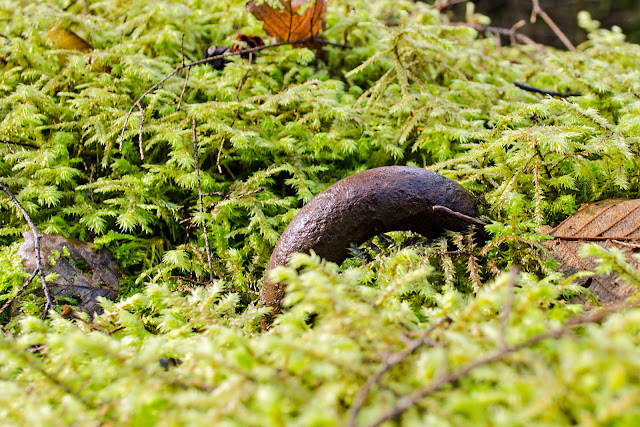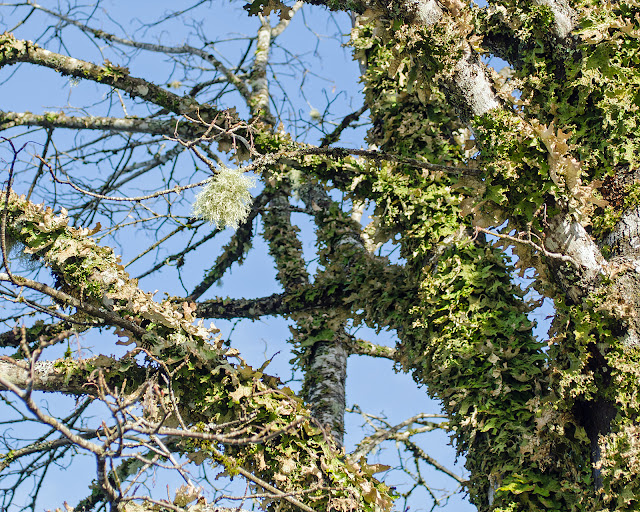In our wet, shady rainforests, sometimes sunlight sneaks under the canopy with its yellow highlighter.
I passed the entrance to a trail leading down into a valley, parked, and went exploring.
 |
| All the colours of green |
It was a short trail that dropped down the hill to a cleared area about the right size for a tiny cabin. It seems that was the plan; there's a good pile of alder firewood, sawed to small woodstove size, now gently rotting, soaked through and growing moss. Tipsy fence posts line the trail, and a solid cement block with a fluffy moss cushion barricades the entrance. No-one has been working on the site, though, for a few years.
 |
| A rusting iron loop embedded in the cement block, peeking through the moss. |
The shady ground between trees is mostly covered in evergreen ferns, still dripping wet on this sunny afternoon. Mosses climb the trees and drape from bare branches.
 |
| Cat-tail moss and Licorice fern. |
Licorice ferns often seem to be growing as single stalks, as in the first photo above, but each stalk has sprouted from a long rhizome that runs along under the moss. The rhizome is brownish, up to a foot long; "they" say (but I have never tested this, because I am reluctant to rip out that beautiful moss) that it tastes of licorice.
Licorice ferns are interesting edibles. More and more restaurants are using them to infuse sauces, make teas, or serve candied. The anise-like flavor is apparent when the root is nibbled raw, but in a sauce I find it much more subtle, with a touch of a licorice sensation on the tongue and a hint of sweetness. (From Fat of the Land)
The fern fronds are evergreen, at least in our wet forests.
 |
| Unidentified moss on a stump. |
I couldn't find this moss anywhere in my book. The individual leaflets (or are they clumps of tinier leaves?) are almost like miniature maple leaves.
At the head of the trail, where sunlight percolates through more consistently, recent wind storms had brought down large quantities of shredded lungwort from far overhead. I found a few overgrown trees within my reach, later on that afternoon, at Rock Bay.
 |
| Lungwort, a few other lichens, and a bit of moss, keeping the tree warm. |
On this tree, the lichen is pale green and brownish; along the trail in the bush, even the torn leaves were much greener. This lichen absorbs water, much as moss does, and becomes green and flexible. Here it is on a rock in Bella Coola:
 |
| Looks good enough to eat. |
Compare those to this, on a dry tree at water's edge, exposed to sunlight and wind.
 |
| The little "warts" are isidia, reproductive structures. |
 |
| Lungwort and a hanging clump of beard lichen. |











Whatan inviting looking trail! And great pictures of the moss and lichens.
ReplyDeleteI learn a lot from your forest walks. - Margy
ReplyDelete